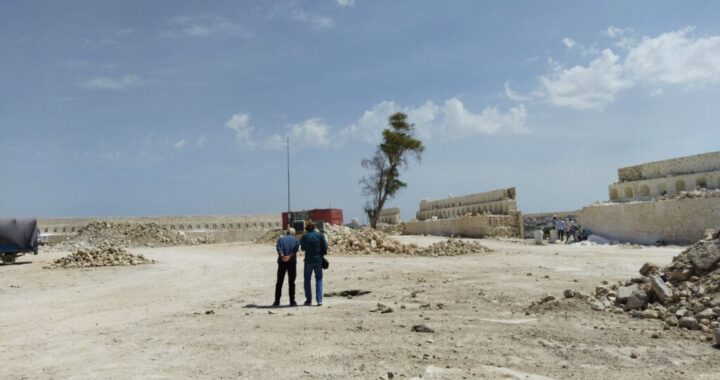Dark tourism. We had to explain it repeatedly while traveling through Iraq. We wanted to visit places that tell the story of the ISIS occupation or the struggle to expel the terror group.
That’s why photographer Eddy van Wessel and I were in Iraq together – at least, that was the story. Because the permit to work as journalists never came through due to a conflict between two departments of the Iraqi government. Other colleagues, with larger budgets, decided to stay in Baghdad and wait for someone from higher up to call for order.
We had limited time to gather material for our reports on Ten years after the ISIS invasion of Mosul, which we were making with the support of the Pascal Decroos Foundation. We didn’t have much choice. We just went, and then as tourists. And in retrospect, it was just as well, because the permit only reached our fixer Faisal Jaber’s mobile phone on our last day.
Hindrance
We reasoned that tourists are welcome in Iraq, and that according to official orders they shouldn’t be hindered. We couldn’t hide that we were journalists, as Van Wessel had just a bit too many professional cameras with him. But journalists also go on vacation, and not just ordinary ones. Moreover, we might want to organize such a dark tourism trip for others. After all, I have guided many tourists in Iraqi Kurdistan.
Not all security agents who checked our passports at the checkpoints believed our story, and Jaber sometimes had a lot to explain. It didn’t help that all those stamps and visas in our ten-year-old passports clearly showed that we had been to Iraq many times before. We might have overdone it a bit.
Still, we were eventually allowed to pass everywhere, except when we tried to enter the Yezidi province of Sinjar. We waited there for an hour in the car, while a storm was approaching, which would accompany us back like a somber farewell. Sinjar was too dangerous, not just for tourists, was the reason for the refusal.
The visit of Turkish President Erdogan to Iraq the next day could have repercussions here. The Turks might bomb the PKK’s Yezidi brigade, as they had done before. Indeed, there was a deadly incident in Sinjar that same day, so the argument wasn’t unfounded.
Darkest
This would indeed have been the darkest point of our tourist trip through Iraq. In the capital Sinjar, hardly anything has been rebuilt, nine years after ISIS was driven out. The shot-up center where ISIS literally dug in would be interesting in this concept. Just like the mass graves of Yezidis killed by ISIS. And Mount Sinjar, where thousands of fleeing Yezidis were trapped for ten days without food or water. And also Kocho, the place that held out against ISIS for two weeks, where all the men were then shot.
We started in Baghdad, which is in the grip of a construction frenzy; a lot of high-rise buildings are going up. Finally, after years, work is being done on the infrastructure to end the daily traffic jams. You might wonder how much that will help, as reopening the Green Zone and removing T-walls didn’t really solve the traffic chaos. Dark tourism doesn’t yield much here.
There’s not much to see any more of the attacks for which those T-walls were there. We searched for the spot where rockets from a US drone hit a militia leader’s car in February, but the holes in the road were hardly visible anymore under the dirt. Only on the airport road does the burnt-out car still stand as a monument to the US drone strike on Iranian General Soleimani a few years ago.
Rebuilt
The Sunni town of Ramadi, which we visited next, has largely been rebuilt. Not many visible reminders of ISIS are left there. Haditha, which was besieged by ISIS for almost two years, is more interesting for the dark tourist. Here we found an entire wall of ‘martyrs,’ civilians who died defending the city. And heroes who survived and were eager to tell their stories. We were promised a museum about the battle would be opened soon as well.
On to Tikrit, where one of the palaces on the Tigris is now a memorial site. There, ISIS murdered thousands of young military recruits. The river carried their bodies away. A dark, oppressive place, perfect for ‘our kind of tourist.’
This also applies to Tal Afar, where Sunni Turkmen killed their Shia Turkmen neighbors and kidnapped women and children. Just as they did with the Yezidis, whom they considered infidels. The Shia were seen as apostates, which was just as bad.
The city center is still largely in ruins. Many Sunni residents have died or are imprisoned. Pro-Iranian Shia militias are in control here now. Dark tourists might find it thrilling to see their followers spying and secretly taking photos of them. We, as journalists, were less impressed.
Divide
The last place, Mosul, can actually be divided in two, with the Tigris as the dividing line. The eastern part, which was liberated first, has been completely rebuilt. Here are nice restaurants, debate centers, expensive shops, the vibrancy of the restored university. There’s nothing dark about it anymore.
The west bank, where the old center is, is still largely in ruins. Here, with foreign aid, more mosques and churches are being rebuilt than homes. Here, bodies are still regularly found under the rubble. Here, the story goes that somewhere in a collapsed basement, millions of dollars from ISIS are hidden, which many have been searching for since.
And those are just a few stories to tell. I believe that Van Wessel and I, without intending to, stumbled upon an interesting new project. Thanks to fixer Faisal Jaber who suggested it. He was right when he pointed it out to me months ago as a potential money-maker. Did I really think he was joking back then…?

